Bulletin – September 2017 Global Economy Trends in Global Foreign Currency Reserves
- Download 694KB
Abstract
Over the decade to 2014, global foreign currency reserves doubled relative to GDP, though balances have declined a little since then. Accompanying this growth has been a shift in the composition of reserves towards higher-yielding assets, including equities and non-traditional reserve currencies, such as the Australian dollar. This article examines the overall growth trend as well as the potential causes of the compositional shift in reserves, including a decline in yields offered by traditional reserve assets and higher reserve balances.
Introduction
Central banks hold foreign currency reserves for a number of reasons, the most important being so that they can intervene in the foreign exchange market (or as a result of previous intervention).[1] Central banks can sell reserves and purchase their own currency to support its value (and vice versa). In Australia's case, over the past 20 or so years the Bank has intervened only in exceptional circumstances, such as in response to significant short-term dislocations in market functioning or to fundamental exchange rate misalignment (Newman, Potter and Wright 2011). For example, during the global financial crisis, the Bank purchased Australian dollars to restore liquidity and reduce exchange rate volatility when market conditions became disorderly (Poole and D'Arcy 2008). Other economies with freely floating currencies also hold reserves in part to restore market function in times of stress (IMF 2015).
In contrast, authorities in countries with an exchange rate that is fixed (pegged) to a particular currency or to a basket of currencies intervene in the foreign exchange market to ensure that the exchange rate is not (too far) above or below its targeted rate.[2] Such intervention can be persistent and can be a key determinant of the level of reserves held. Central banks with pegged or otherwise managed exchange rate regimes may be required to hold large amounts of foreign exchange reserves in order to demonstrate their ability to defend the exchange rate against speculative attacks (Obstfeld and Rogoff 1995). These reserves also provide a protective buffer for a central bank that can be called upon to meet balance of payments financing needs if required, which is important in ensuring the orderly functioning of capital and foreign exchange markets.[3]
Foreign currency reserves are primarily invested in high-quality assets, such as the sovereign bonds of advanced economies. Such assets offer more stable returns than assets such as equities and, therefore, provide assurance that the value of reserves will be maintained and available when needed. However, holding foreign currency reserves in high-quality assets is costly since reserves could be invested in other types of assets that earn higher income (have a higher yield).
Reserve holdings can have implications for a central bank's balance sheet. Holding unhedged foreign currency assets (whereby the currency exposure is not converted back to local currency with derivatives) results in an exposure to exchange rate fluctuations, and central banks also face interest rate risk and credit risk on the foreign currency securities that they hold.
Drivers of Growth in Foreign Currency Reserves
Global foreign currency reserves increased significantly over the decade to 2014, almost doubling as a share of global nominal GDP (Graph 1).[4] However, balances have declined a little since then. These moves have predominantly reflected trends in the reserves balances of countries that maintain an exchange rate pegged to a particular currency or to a basket of currencies (Graph 2). The most important of these is China, which accounted for around 40 per cent of the rise in global reserves over the decade to 2014. Countries with floating exchange rates, but which intervene occasionally, also contributed to the increase in reserves in the decade up to 2014. In contrast, countries that rarely intervene in the foreign exchange market, and so are classified as having freely floating exchange rates, have had more modest growth in reserves over the period.
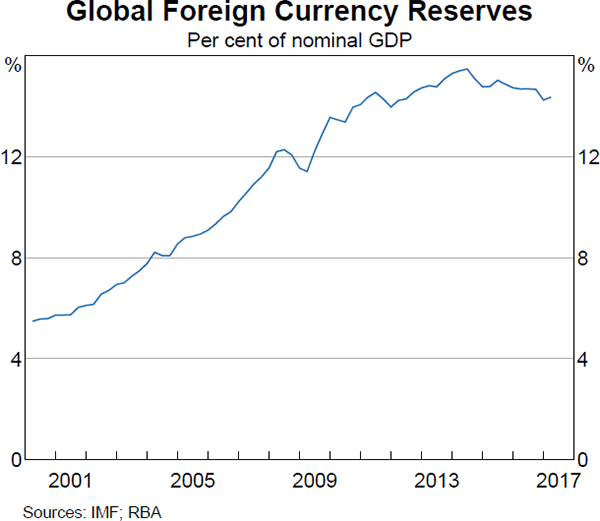
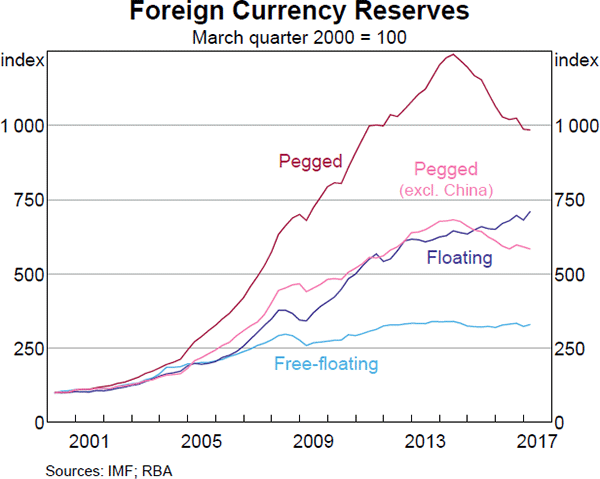
Movements in the US dollar appear to have driven a large share of the movements in global foreign currency reserves over the past 15 years. This reflects both the large, persistent movements in the US dollar over this period and the importance of the US dollar as a currency peg. The US dollar is the most common bilateral peg; it is a major component of many currency baskets and around one-quarter of all currencies are pegged directly to it. Between 2002 and 2008, the US dollar depreciated by around 30 per cent on a trade-weighted basis, contributing to upward pressure on currencies pegged to it. The US dollar remained at a low level until 2014 when it started appreciating in anticipation of the (gradual) removal of monetary stimulus in the United States.
The importance of US dollar movements to foreign currency reserves is evident from its role in the rapid build-up of Chinese foreign currency reserves (Graph 3). For much of the period after mid 2005 (when the de facto peg to the US dollar was removed), the People's Bank of China (PBC) has managed the renminbi within a tight trading band against an undisclosed basket of currencies, of which the US dollar was considered to be the most important.[5] As the US dollar depreciated, the PBC intervened in the spot foreign exchange market to contain appreciation pressure on the renminbi. Although the CNY/USD exchange rate appreciated (aside from a two-year pause beginning in mid 2008 associated with the global financial crisis), the trade surplus remained large as a share of GDP, which contributed to foreign currency inflows. While not as important as the trade surplus, foreigners continued to invest in China, placing additional appreciation pressure on the currency. These inflows were driven by expectations of high rates of return on investments in China given rapid productivity growth, the gradual relaxation of restrictions on capital inflows and expectations of further appreciation in the renminbi (Hatzvi, Meredith and Nixon 2015). In order to manage the currency, the Chinese authorities sold renminbi to purchase foreign currency reserves.
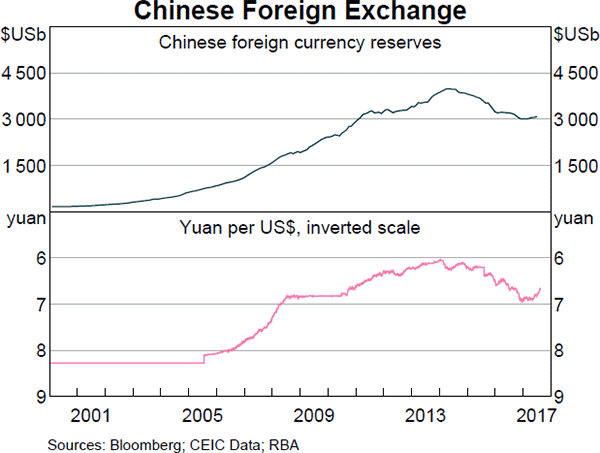
There has been some reversal of this effect since the US dollar started to appreciate in 2014. Indeed, China has accounted for the overwhelming majority of the decline in global reserves since that time. Up until recently, this occurred alongside net capital outflows from China. In part, these capital outflows reflected expectations that the renminbi would depreciate. But they also reflected changing expectations for Chinese economic growth, which has reduced the attractiveness of China as a place to invest. Chinese economic and financial market policy has also had an influence. For instance, the gradual relaxation of capital account restrictions, notwithstanding some recent tightening with respect to outflows, and the increased flexibility in the exchange rate from 2014 are likely to have made it easier for Chinese residents to make investments outside of China.
While growth in reserves in China has been particularly important for global reserves growth, there has also been significant growth in reserves held by other countries with currencies pegged to the US dollar, either directly or as part of a currency basket, such as Hong Kong and Singapore. Movements in the euro are also likely to have contributed to growth in reserves for countries that maintain a currency peg. For example, the Central Bank of Denmark and the Czech National Bank increased intervention to offset substantial inflows following the European debt crisis and the move to negative yields in the euro area. However, movements in the euro are likely to have had a smaller effect on foreign currency reserves than those in the US dollar. The euro depreciated by less than the US dollar (20 per cent against a broad range of currencies from 2009 to 2015) and, although it is the most common currency peg on a bilateral basis behind the US dollar, countries pegged to the euro account for a smaller share of global foreign exchange reserves than those pegged to the US dollar. For currencies that are pegged to a basket, the euro also tends to have a smaller weight in these currency baskets than the US dollar.
Movements in the US dollar and the euro are also likely to have contributed to the growth in reserves in countries with floating currencies (market-determined currencies that are subject to occasional intervention). This group of currencies includes those from some European and south-east Asian economies, which have strong trade links with the United States and the euro area. A number of these countries have explicitly stated that they intervened to offset appreciation pressure from movements in the US dollar or the euro. For example, reserves held by the Swiss National Bank have grown noticeably since the financial crisis as a result of extensive intervention; reserve accumulation occurred both within and outside the three-year period when the Swiss franc was pegged to the euro (Jordan 2016).[6] In south-east Asia, the Bank of Thailand intervened to offset appreciation pressure on its currency as a result of unconventional monetary policies of advanced countries, while Bank Indonesia has consistently intervened to stabilise its currency (Bank Indonesia 2017; Bank of Thailand 2013). However, foreign currency reserve accumulation was broadly based among economies with currencies classified as floating.
In contrast, reserves held by countries with a free-floating exchange rate – those with no prescribed target and only occasional intervention in response to exceptional circumstances such as the Australian dollar – have only increased modestly since the early 2000s. Accordingly, these countries tend to hold lower reserve balances than countries with other currency arrangements. Australia's foreign currency reserves have grown by around 6 per cent over this period, around half of the pace of growth of global reserves. This group of countries partly holds foreign currency reserves for precautionary reasons, but it is not clear to what extent reserves growth reflects growth in these requirements.[7]
Another important, but less influential, factor for global foreign currency reserves growth is the price of oil (Graph 4). Many oil-exporting countries receive significant US dollar inflows in the form of oil sale proceeds, and these can contribute to the build-up of foreign currency reserve balances. Indeed, the foreign currency reserve balances of oil-exporting countries broadly tracks the price of oil. Oil exporters' reserves increased noticeably up to the end of 2014, but have declined considerably since. It is difficult to determine how significant the oil price is for growth in reserves of oil-exporting countries since many oil-producing nations peg their currency to the US dollar, and therefore changes in reserve balances may reflect intervention to maintain the currency peg. Also, many oil-producing nations deposit the proceeds of oil exports into sovereign wealth funds, which are typically reported separately to foreign currency reserves.[8]
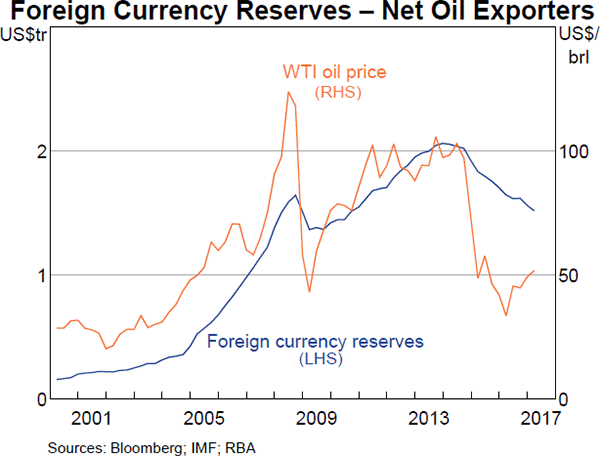
Trends in Asset and Currency Allocation
As discussed, foreign currency reserves are generally held in low-risk (and lower-yielding) assets such as the sovereign bonds of advanced economies and cash deposits at other central banks (Table 1). They have also typically been concentrated in a few advanced economy currencies, with the US dollar accounting for around two-thirds of global reserves (Graph 5).
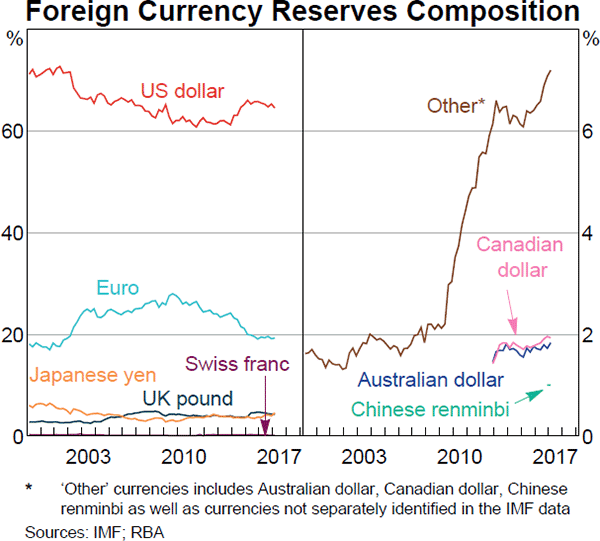
In the case of Australia, foreign currency reserves are primarily invested in these assets.[9]
High-quality liquid assets denominated in traditional reserve currencies still account for the majority of countries' reserve holdings. Nevertheless, since the global financial crisis there has been a shift towards higher-yielding assets, such as corporate bonds and equities, as well as assets denominated in non-traditional reserve currencies, such as the Australian dollar. This followed a marked reduction in yields on traditional reserve assets. The share of total reserves allocated to non-traditional currencies rose from 2 per cent in 2009 to close to 7 per cent in 2017. The Australian and Canadian dollar each account for around one-quarter of total non-traditional currency reserves, and are included in around two-thirds of all reserve portfolios.
Similarly, holdings of equities in reserve portfolios also appear to have increased since the global financial crisis (Graph 6). Data from various reserve manager surveys suggest that around 20 per cent include equities in their reserve portfolios, up from around 10 per cent prior to the crisis (Table 1). Reserve managers of portfolios with some exposure to equities typically allocate around 7–10 per cent of their total reserve portfolio to the asset class, and this allocation appears to be weighted towards larger companies of advanced economies. This recent shift in reserve portfolios towards higher-yielding assets is significant given that allocation changes tend to occur gradually, reflecting the generally conservative nature of reserve management.
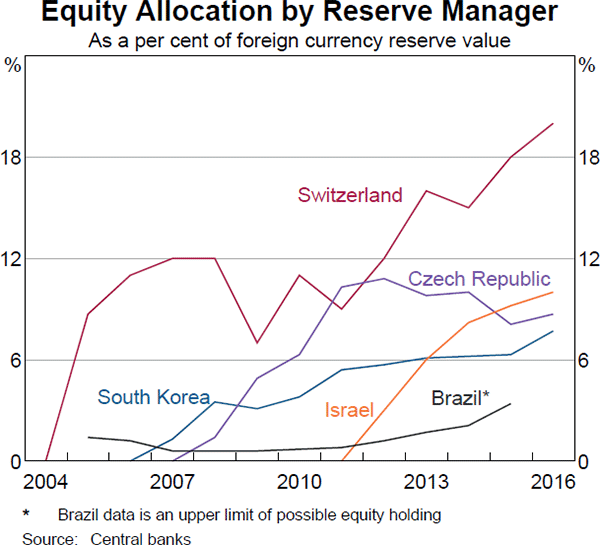
Generally, currency allocation and the choice of assets are driven by preferences for liquidity and capital preservation, which tend to take precedence over other considerations, such as the income earned on investments. Although they are frequently considered to be interdependent, reserve managers can consider the currency allocation decision separately from the choice of asset exposures. For example, a reserve manager may decide on an asset allocation, and then use other financial instruments, such as foreign exchange swaps or options, to achieve the desired currency exposure. While currency and asset allocation decisions can be driven by different factors, the fact that the shift towards non-traditional currencies and assets occurred around the same time suggests that these changes have been driven by some common factors.
| Proportion of portfolios with some exposure | Value held(a) | ||
|---|---|---|---|
| 2002–05 | 2014–17 | 2014–17 | |
| Deposits at central banks | 95 | 95 | 10–15 |
| US Government securities | 90 | 90–95 | na |
| Supranational bonds | 85 | 90–95 | na |
| Deposits at commercial banks | 95 | 85 | 10–15 |
| Agency bonds(b) | 65–70 | 60–70 | na |
| Corporate bonds | 17–22 | 35–40 | 12 |
| Equities | 5–10 | 15–20 | 7–10 |
| Emerging market bonds | na | 20–30 | 6–7 |
|
(a) Average share held by those foreign currency reserve portfolios that maintain
some exposure to the asset class Sources: BIS; HSBC; IMF; JP Morgan; RBS |
|||
There are several benefits of holding foreign currency reserves in non-traditional asset classes and currencies. By increasing the number of different types of assets in a reserve portfolio, the effect of individual risks on reserve valuations is likely reduced, as the portfolio is more diversified. Since these assets also tend to offer higher yields, they increase the income earned by portfolios. However, holding non-traditional assets comes at the expense of greater exposure to credit, liquidity and currency risks. The shift to non-traditional assets around the time of the global financial crisis partly reflects changes in the relative yields of traditional and non-traditional assets. However, it is also likely to have reflected the accumulation of large reserve balances and changes in the characteristics of sovereign bond markets. The remainder of this section discusses these factors.
During the global financial crisis, yields on traditional reserve assets, such as US Treasury bonds, declined sharply in response to more accommodative monetary policies. This low-yield environment greatly reduced the income generated on reserve balances, with some major sovereign bonds offering near-zero or negative yields. This increased the differential between the yields on US government bonds and those on government bonds from other countries (Graph 7), and is likely to have encouraged some reserve managers to diversify into these and other higher-yielding assets. This would have been especially true for those reserve managers who seek to achieve a fixed rate of return. It is also consistent with responses to various reserve manager surveys, which highlight the shift to a low-yield environment as an important consideration in the investment management process. The effect of low yields on reserve holdings is also consistent with the sharp decline in reserve holdings of euro-denominated assets in 2014 and 2015. Yields on shorter-term European sovereign bonds have been negative since around mid 2014, following a reduction of target policy rates, and have remained so since the expansion of the European Central Bank's asset purchase program in early 2015.
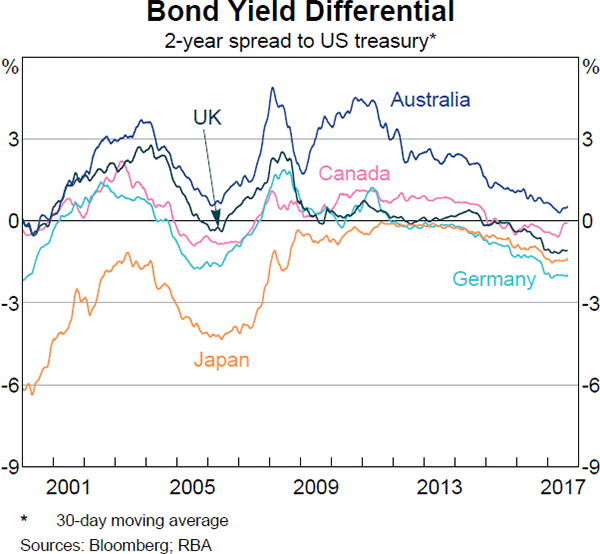
The size of reserve balances is also important. If foreign currency reserve balances have expanded as a consequence of exchange rate intervention, rather than for precautionary purposes, then there is likely to be excess capacity with which to invest in higher-yield assets. The global build-up of reserves, which in part was a result of persistent foreign exchange intervention, is therefore likely to have facilitated the shift into higher-yielding assets.[10] Indeed, the shift towards equities in particular appears to be limited to countries that greatly expanded their reserve holdings as part of the implementation of exchange rate management practices. Some countries, such as the Czech Republic and Switzerland, have explicitly stated that the inclusion of equities in their reserve portfolio reflects a more efficient use of the reserves in excess of the amount required for precautionary purposes (Singer 2015; Maechler 2016). In contrast, many countries with a free-floating exchange rate, such as Australia, Japan and the United Kingdom, do not include equities in their portfolios.
Changes in the characteristics of sovereign bond markets may also have altered foreign currency reserve holdings. For example, downgrades in the credit ratings of sovereign bonds from a number of peripheral European countries around the time of the financial crisis reduced the pool of high-quality sovereign bonds available for inclusion in foreign currency reserve portfolios. This may have caused some reallocation into other high-quality assets, including non-traditional ones. This is likely to have been particularly important for reserve managers who limit their investments in lower-rated assets; around 30 per cent of reserve portfolios are limited to investments in AA- rated debt or higher. Concerns about the credit-worthiness of peripheral European countries may also have shaped reserve managers' outlook for the euro in 2010 and again in 2012, further reducing the attractiveness of euro-denominated investments.
In contrast, the strong credit ratings of Australia and Canada may have increased the relative attractiveness of government debt issued in these countries. In addition, increases in government debt on issue in Australia and Canada improved liquidity and the ease of transacting in these government debt markets. Taken together, these factors are likely to have encouraged the greater adoption of assets denominated in these currencies in reserve portfolios.
Implications and Outlook
Over the past 15 years, trends in global foreign currency reserves appear to have been largely driven by intervention in response to movements in the US dollar and, to a lesser extent, the euro. As such, the future direction of these currencies is likely to be important for foreign currency reserves growth. Future appreciation of one of these major currencies would tend to limit the growth of global foreign currency reserves as other countries are less likely to want to intervene to prevent their currencies appreciating. The exchange rate and capital control policies of China are also likely to continue to be an important driver of global holdings of reserves.
There is uncertainty about whether the increase in the share of reserves held in higher-yielding assets and non-traditional currencies will persist for an extended period. One reason it might is because changes in foreign currency reserve composition tend to occur slowly and be persistent. However, it is possible that demand for these assets will decline as yields on more traditional assets rise. The size of future reserve balances may also influence the allocation to higher-yielding assets given that larger balances, all else being equal, tend to provide greater capacity to invest in alternative assets, particularly equities.
Another issue is whether non-traditional reserve assets reduce the effectiveness of foreign currency reserves. This is because these assets, in particular equities, can be more susceptible to falls in value, particularly in periods of market stress when reserves are more likely to be required. For example, at the height of the global financial crisis in late 2008, US equities fell by around 30 per cent over a four-week period while yields on long-term US Treasury bonds were little changed. However, there are a number of reasons why this is not likely to be a significant issue, based on the data that are available. First, the allocation to equities appears to be modest both in terms of the number of reserve funds and the value of reserves held at a global level. Second, the inclusion of equities in reserve portfolios has been more prevalent in countries that have reserves that appear to be in excess of required precautionary balances.
Footnotes
The author is from International Department. [*]
In some countries, such as Japan, reserves are owned and/or controlled by the ministry of finance rather than the central bank. Australia's foreign currency reserves are managed by the Reserve Bank and sit on the Bank's balance sheet. [1]
The IMF classifies exchange rate arrangements into various categories. Floating exchange rates are largely market determined without a prescribed target, but intervention is conducted occasionally. Free-floating exchange rates are floating rates but intervention is rare; limited to three instances of intervention over six months. For the purpose of this article, we classify all other IMF categories as pegged arrangements. This article applies the exchange rate classification from the 2015 IMF Annual Report on Exchange Arrangements and Exchange Restrictions throughout the entire period under analysis. Exchange rate regimes may vary over time. Of note, some countries that had a pegged currency for a period, such as Switzerland, are classified as floating for the purposes of this article. [2]
In Australia's case, reserves can also assist in domestic liquidity management operations and foreign exchange transactions on behalf of the government (Vallence 2012). [3]
In this article we use gross reserves data from the IMF and limit our assessment to foreign currency reserves excluding gold and other holdings. This measure accounts for the majority of official reserve assets. Gross reserve balances include outright purchases of foreign currency and also ‘borrowed’ foreign currency such as that accumulated via a foreign exchange swap. The currency composition of these reserves is likely to differ from net reserve balances reported by country authorities. Where the value of foreign exchange swaps is significant, gross reserves data might not reflect a portfolio's underlying exchange rate risk. [4]
From mid 2005 to August 2015 the PBC managed the renminbi within a gradually widening band against an undisclosed basket of currencies (the band was widened from ±0.3 per cent around a mid point, to ±0.5 per cent in May 2007; ±1 per cent in April 2012; and ±2 per cent from March 2014). Since then, the PBC has managed the trading band against the US dollar, as well as with reference to the currencies included in the published China Foreign Exchange Trade System effective exchange rate basket (with the trading band for these currencies greater than ±2 per cent). [5]
The Swiss franc was pegged to the euro between late 2011 and early 2015. However, this article (based on exchange rate regimes in 2015) classifies Switzerland as having a floating exchange rate. Changing Switzerland's classification does not materially affect the results. [6]
There is no widely accepted framework to determine the value of foreign currency reserves a country should hold for precautionary purposes. Some commonly cited metrics include the ratio of a country's foreign currency reserves to imports, short-term debt and broad money (IMF 2015). However, the usefulness of these metrics depends largely on country-specific characteristics, such as capital account openness. Different metrics can yield very different results for reserves adequacy. For example, IMF guidelines indicate that China's current level of reserves are ‘sufficient’ based on the import and short-term debt coverage ratios, but not according to the broad money ratio (Table 3 of IMF (2016)). [7]
Sovereign wealth funds (SWFs) facilitate the saving and intergenerational transfer of wealth accumulated from the sale of non-renewable resources. They also assist in insulating economies from swings in commodity prices. Reflecting their longer-term objectives, SWFs are typically invested in higher-yielding assets than foreign currency reserves. Similarly to reserve balances, SWFs have also increased considerably in size over the past 15 years. [8]
Australia's foreign currency reserve holdings are limited to deposits at official institutions, including central banks, and debt instruments guaranteed or issued by sovereigns, central banks and supranationals. The currency allocation of Australia's reserve holdings is guided by an internal benchmark, which is predominantly denominated in US dollars and euros. This benchmark also includes Canadian dollars, Chinese renminbi, Japanese yen, South Korean won and UK pounds. The Bank also holds a small investment in the Asian Bond Fund. See RBA (2017) for further discussion. [9]
The depositing of intervention proceeds into sovereign wealth funds by some central banks may have slowed the accumulation of foreign currency reserves. Given that these funds are more likely to hold growth assets, the shift to higher-yielding assets seen in foreign currency reserves data may understate the shift in a broader measure of official foreign currency assets. [10]
References
Bank Indonesia (2017), ‘BI 7-day Revers Repo Rate Held at 4.75 per cent Maintaining Stability and Promoting National Economic Recovery Momentum’, Media Release No 19/53/DKom, 20 July.
Bank of Thailand (2013), ‘Foreign exchange policy and intervention under inflation targeting in Thailand’, BIS (Bank for International Settlements) Papers No 73, pp 325–333.
Hatzvi E,J Meredith, and W Nixon (2015), ‘Chinese Capital Flows and Capital Account Liberalisation’, RBA Bulletin, December, pp 39–48.
IMF (2015), ‘Assessing Reserve Adequacy – Specific Proposals’ IMF Policy Paper, April.
IMF (2016), ‘The People's Republic of China: Staff Report for the 2016 Article 4 Consultation’, IMF Country Report No 16/270.
Jordan T (2016), ‘The euro and Swiss Monetary Policy’, Speech at the Europa Forum, Lucerne, 2 May.
Maechler A (2016), ‘Investment Policy in Times of High Foreign Exchange Reserves’, Speech at the Money Market Event, Zurich, 31 March.
Newman V,C Potter, and M Wright (2011), ‘Foreign Exchange Market Intervention’, RBA Bulletin, December, pp 67–76.
Obstfeld M and K Rogoff (1995), ‘The Mirage of Fixed Exchange Rates’, NBER Working Paper No 5191.
Poole E and P D’Arcy (2008), ‘Liquidity in the Interdealer Foreign Exchange Market’, RBA Bulletin, December, pp 1–6.
RBA (2017), ‘International Market Operations’, Reserve Bank of Australia site.
Singer (2015), ‘How to Gain from Equities’, Czech National Bank site, 10 June. Available at <https://www.cnb.cz/en/public/media_service/interviews/media_2015/cl_15_150610_singer_gpi.html>.
Vallence C (2012), ‘Foreign Exchange Reserves and the Reserve Bank's Balance Sheet’, RBA Bulletin, December, pp 57–64.